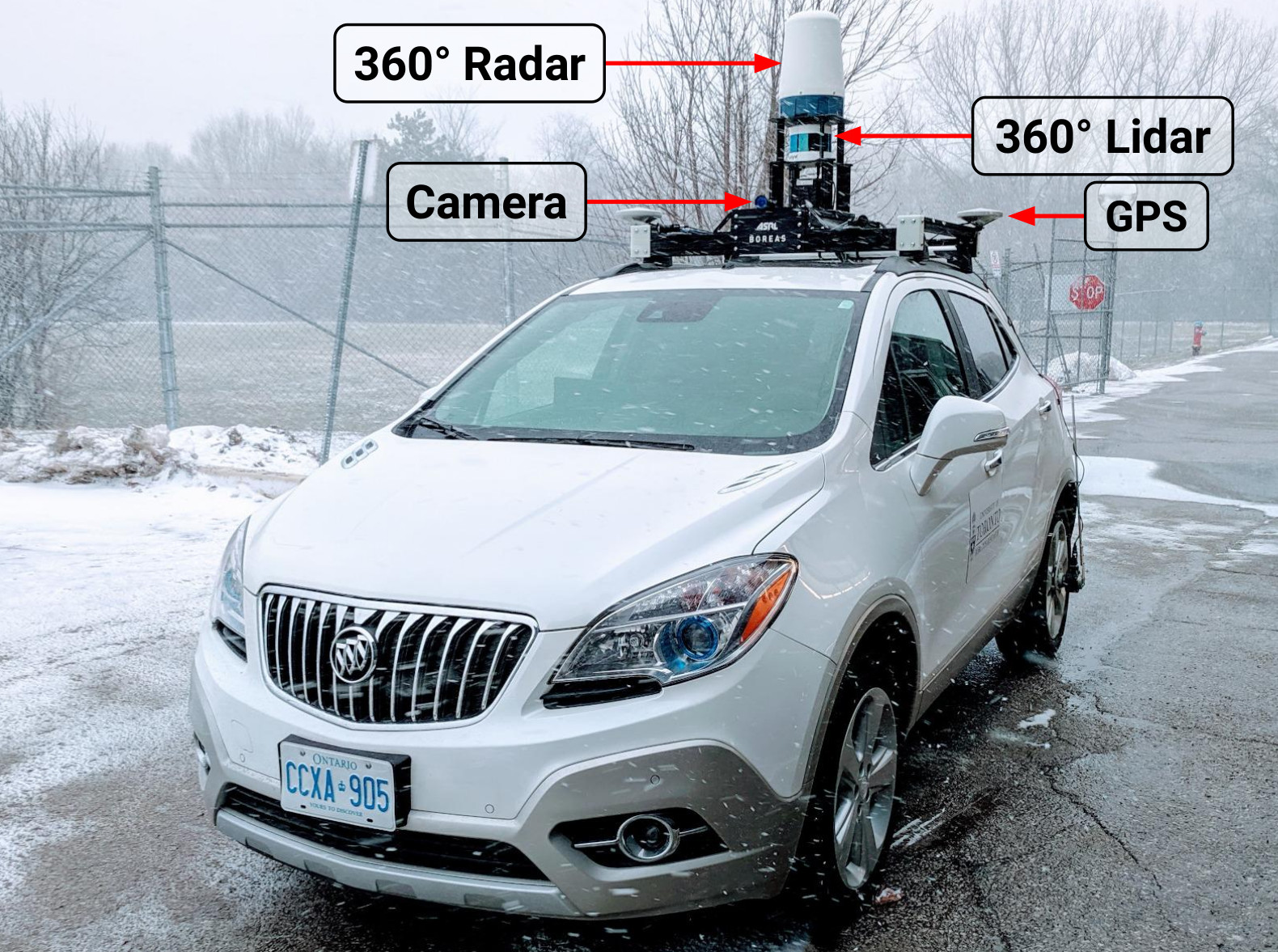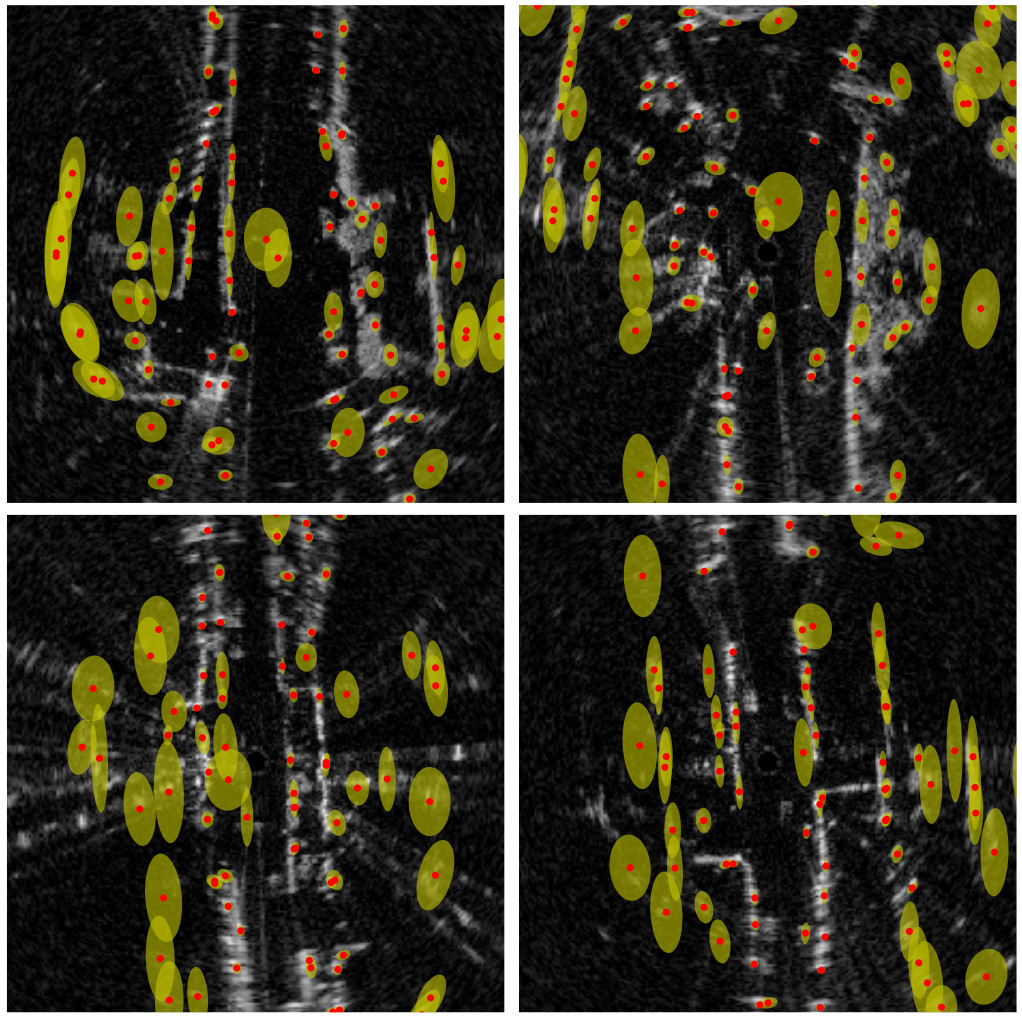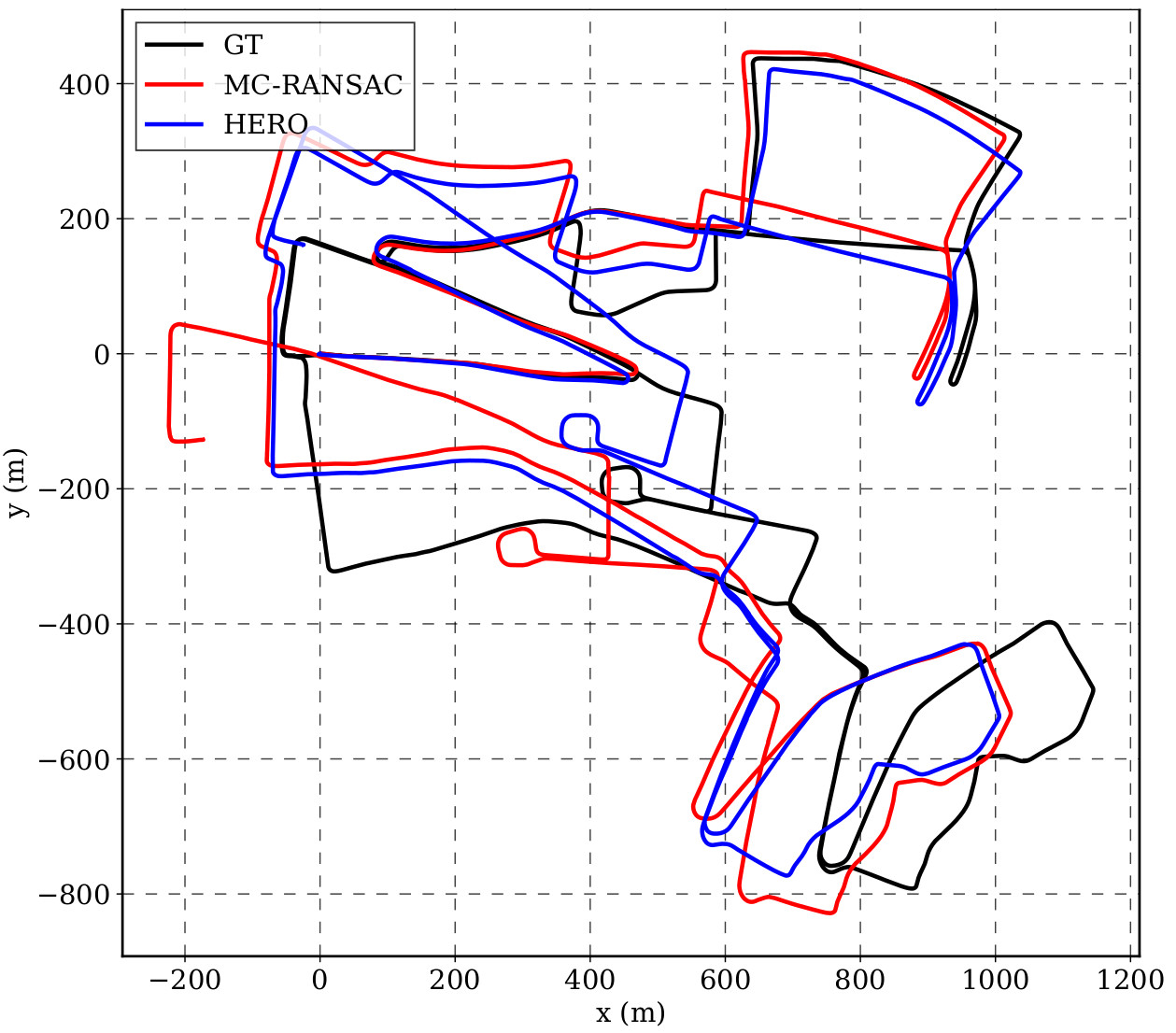HERO (Hybrid-Estimate Radar Odometry) combines probabilistic state estimation and deep learned features. The network is trained in an unsupervised fashion. Deep learning is leveraged to process rich sensor data while classic state estimation is used to handle probabilities and out-of-distribution samples through outlier rejection schemes. To our knowledge, this is the first example of a totally unsupervised radar odometry pipeline. Our pipeline aproaches the performance of the current state of the art in point-based radar odometry, Under the Radar, while being unsupervised.
(2021-12-14): Boreas: A Multi-Season Autonomous Driving Dataset: We have made our dataset publicly available along with a development kit, pyboreas, and public leaderboards for odometry, localization, and object detection.
Our implementation uses PyTorch for the deep network, and C++/STEAM for the state estimation back-end. We use a sliding window of length 4 to obtain the best results. Note that we train using a fixed seed (0) in order to make our training results more reproducible.
This repository also provides an implementation of Dan Barnes' Under the Radar.
We trained and tested these networks on the Oxford Radar Robotcar Dataset. Results of our method compared against others is provided below. HC: Hand-crafted, L: Learned. In our paper, we also provide results on 100 km of data collected using our own platform, shown below. In addition, our paper provides results comparing the performance of radar odometry in sunny and snowy weather.
| Methods | Supervision | Translational Error (%) | Rotational Error (1 x 10-3 deg/m) |
|---|---|---|---|
| Under the Radar | Supervised (L) | 2.0583 | 6.7 |
| RO Cen | Unsupervised (HC) | 3.7168 | 9.5 |
| MC-RANSAC | Unsupervised (HC) | 3.3204 | 10.95 |
| HERO (Ours) | Unsupervised (L) | 1.9879 | 6.524 |
Radar Odometry Combining Probabilistic Estimation and Unsupervised Feature Learning
@INPROCEEDINGS{burnett_rss21,
title={Radar Odometry Combining Probabilistic Estimation and Unsupervised Feature Learning},
author={Burnett, Keenan and Yoon, David J and Schoellig, Angela P and Barfoot, Timothy D},
booktitle={Robotics: Science and Systems},
year={2021}
}
We provide a Dockerfile which can be used to build a docker image with all the required dependencies installed. It is possible to build and link all required dependencies using cmake, but we do not provide instrucions for this. To use NVIDIA GPUs within docker containers, you'll need to install nvidia-docker
cd docker
docker build -t hero-image .
docker run --gpus all --rm -it \
--name hero_docker \
-v <path_to_dataset>:/workspace/<dataset_path> # Change to loc of oxford data
--shm-size 16G \
--ipc=host -p 6006:80 \ # tensorboard within docker at port 80 to 6006 on host
hero-image:latest
After launching the docker container, clone repo and build C++ code:
git clone git@github.com:utiasASRL/hero_radar_odometry.git
cd hero_radar_odometry
mkdir cpp/build
cd cpp/build
cmake .. && make
To train a new model, we provide train.py, which can be used as follows:
python3 train.py --pretrain <optional_pretrained_model_path> --config <config_file_path>
Note that we publish training results to tensorboard.
The tensorboard logs are saved to data_dir, as defined in the config file. Update this to your desired log folder.
As a convenience, we have provided pre-trained models and their associated config files which can be downloaded using download_models.sh. Among the pre-trained models are HERO (window size 2, 4) and UnderTheRadar (window size 2). Our implementation of UnderTheRadar achieves 3.08 % translation error and 10.7 deg/1000m rotation error.
To evaluate a trained model, use eval.py with the following format:
python3 eval.py --pretrain <pretrained_model_path> --config <config_file_path>
model : HERO or UnderTheRadar
data_dir : set to the parent directory of the oxford dataset sequences
log_dir : write tensorboard logs to this directory
cart_resolution : meters per pixel in the cartesian radar input to the DNN
cart_pixel_width : width of the cartesian radar input in pixels
train_split : indices of the oxford sequence used for training
validation_split : index of the oxford sequence used for validation
test_split : indices of the oxford sequence used for testing
networks[unet][bilinear] : true: use bilinear intep, false: use transposed conv (EXPERIMENTAL)
networks[unet][first_feature_dimension] : depth of first CNN
networks[keypoint][patch_size] : width of spatial softmax patches in pixels
networks[softmax][softmax_temp] : softmax temp T = (1 / (this parameter))
steam[weight_matrix] : If true use a 2x2 weight matrix, if false use a scalar weight
steam[log_det_thres_flag] : If true, treshold on log(det(W)) > param during eval
steam[log_det_thres_val] : At test time, can be used to treshold on log(det(W)) > param
steam[log_det_topk] : The minimum number of features that must be retained after filtering (use NMS)
steam[use_ransac] : true: use RANSAC to find inlier set at test time, send inliers to STEAM
steam[ransac_version] : 0: rigid RANSAC, 1: MC-RANSAC
steam[use_ctsteam] : true: uses the approx timestamp of each measurement to do motion compensation
steam[ex_translation_vs_in_s] : translation from sensor to vehicle as measured in sensor
steam[zero_vel_prior] : zero velocity prior on dims outside of SE(2)
steam[vel_prior] : use previously esimated velocity as an additional prior
lr : learning rate
window_size : size of the sliding window esimator in frames (2 = normal frame-to-frame)
augmentation[rot_max] : Random rotation augmentation sampled from uniform[-rot_max, rot_max]
- Train with batchsize > 2




